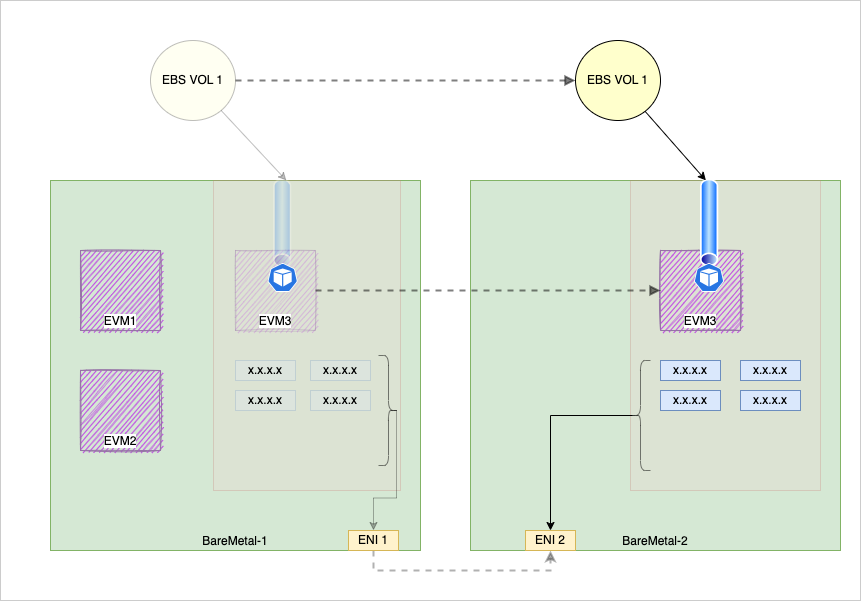Content
- The Need for Live Migration in Kubernetes
- Challenges in Kubernetes and EKS for Long-Running Stateful Workloads
- The Operational Overhead and Cost of Maintaining High Availability
- How Stateful and Mission-Critical Workloads Are Affected by Disruptions
- What is EMP (Elastic Machine Pool) by Platform9?
- Real-World Use Cases of EMP Reducing Operational Friction
- How EMP Can Significantly Reduce Cloud Resource Costs
- EMP as a Key to Enterprise-Grade Kubernetes
Running long-running, stateful workloads like databases, data pipelines, and machine learning models on Kubernetes, especially in AWS’s EKS, comes with significant challenges. Downtime, service disruptions, and inflated costs are big hurdles.
While Kubernetes excels in managing stateless workloads, it struggles with stateful applications due to a lack of native support for live migration. This leaves critical services vulnerable to disruptions during scaling, updates, or node failures. Many teams resort to expensive over-provisioning or complex manual workarounds to maintain availability.
Elastic Machine Pool (EMP) by Platform9 lets us get over these limitations, introducing seamless live migration for Kubernetes environments. With EMP, stateful pods can automatically migrate across nodes without any disruptions, simplifying operations. The bonus is that it also helps with optimizing cloud spend.
Let’s explore the specific challenges associated with live migration on Kubernetes, how EMP overcomes these hurdles, and why it’s a game-changer for EKS users by solving a long-running problem in the Kubernetes ecosystem.
The Need for Live Migration in Kubernetes
Kubernetes was built to handle stateless workloads with ease. For stateful services, like databases or any long-running workloads, it’s a different story. The platform lacks built-in live migration capabilities, which means stateful applications are often disrupted during maintenance activities, scaling, or node failures. In an AWS EKS environment, this can translate into service interruptions, unscheduled downtime, and higher operational costs.
Without native live migration, achieving high availability for stateful workloads becomes a significant burden. Users often have to over-provision resources, set up complex failover mechanisms, or tolerate downtime during critical operations. These workarounds add operational complexity and inflate cloud bills, making a strong case for a more streamlined approach.
Challenges in Kubernetes and EKS for Long-Running Stateful Workloads
Kubernetes, including EKS, does not have general availability (GA) support for live migration of stateful workloads. When running applications that require continuous uptime, this poses a major issue.
Currently, Kubernetes operations rely on Pod Disruption Budgets (PDBs), StatefulSets, and other mechanisms to manage disruptions. However, these methods only reduce the impact of downtime; they don’t eliminate it.
The Operational Overhead and Cost of Maintaining High Availability
Maintaining uptime in the absence of live migration often means over-provisioning instances to ensure spare capacity is available, which drives up cloud costs. For example, during node upgrades or scaling events, stateful applications need to restart, potentially causing brief outages or delays that can disrupt service quality.
These challenges become more pronounced with workloads that require low latency and high availability.
How Stateful and Mission-Critical Workloads Are Affected by Disruptions
Downtime or service degradation can have serious consequences for mission-critical workloads. Consider an e-commerce platform’s database, a data processing pipeline for real-time analytics, or an AI model that serves live predictions. Even minor interruptions can lead to significant business impacts, such as revenue loss, data inconsistencies, or service degradation.
Current Options for Live Migrating Pods in Kubernetes/EKS
There are some existing methods for migrating stateful workloads in Kubernetes, but they come with limitations:
- Workload Failover and Redeployment: This involves creating multiple replicas and handling failover manually, leading to increased complexity.
- StatefulSet Rolling Updates: Useful for sequentially updating stateful applications but does not support actual live migration.
- CRIU (Checkpoint/Restore in Userspace): An experimental method for live container migration. However, it requires stitching together several custom components, is not production-ready, and has limited support in Kubernetes.
These options demonstrate that, while some approaches exist, none offer a robust, out-of-the-box solution for live migration within EKS.
What is EMP (Elastic Machine Pool) by Platform9?
Elastic Machine Pool (EMP) is designed specifically to fill this gap. It extends Kubernetes and EKS capabilities by enabling seamless live migration of pods, even stateful ones. EMP’s architecture is built on three core pillars:
- Dynamic Resource Management: EMP dynamically manages resource allocation across clusters to optimize usage while ensuring availability.
- Live Pod Migration: Allows running pods to move across nodes without service disruption, maintaining active connections and preserving state.
- Automated Failover and Recovery: EMP automates node recovery and workload redistribution, significantly reducing manual intervention.
By leveraging these capabilities, EMP integrates natively with Kubernetes and EKS to make live migration practical for everyday operations, ensuring that workloads continue to run smoothly even during node updates, scaling, or unexpected failures.
Figure 1 – EMP Architecture on AWS

Live Migration with EMP: Minimizing Pod Disruption
EMP provides the ability to seamlessly move running pods between nodes in an EKS cluster using our live migration capabilities. When a node requires maintenance, the live migration feature ensures that workloads are relocated without restarting or losing active connections.
The live migration process involves transferring the EVM state from the source to the target bare metal node while the source EVM workload continues to run. This strategy is fast, safe, and easily cancellable, making it ideal for minimizing downtime in most scenarios.
Figure 2 – EMP Kubernetes Live Migration flow

Unlike traditional failover strategies, EMP handles the migration automatically and keeps the workloads accessible throughout the process.
Reducing Downtime for Long-Running Stateful Services
With EMP, long-running stateful services experience near-zero downtime. It takes care of all the background details, such as maintaining active network connections, migrating memory states, and ensuring data consistency. This capability is especially valuable for services that demand high availability, like databases, real-time analytics, and continuous deployment pipelines.
Real-World Use Cases of EMP Reducing Operational Friction
For organizations running complex, multi-tiered applications in EKS, EMP drastically simplifies maintenance workflows:
- Database Clusters: Database services can migrate across nodes during planned maintenance without any client-facing impact.
- Data Processing Pipelines: Pipelines that handle high-throughput data streams can maintain continuous processing, even as infrastructure changes occur.
- Machine Learning Models: AI models can run uninterrupted, ensuring consistent availability for real-time predictions.
The application patterns can be anywhere from very dynamic, microservices architecture, to more long-running workloads. With the ability to support dynamic resource allocation and persistent resources where needed, EMP is designed to match the demand of the application with the resources needed for it to perform .
How EMP Can Significantly Reduce Cloud Resource Costs
By enabling live migration, EMP allows organizations to right-size their Kubernetes clusters without needing to over-provision resources. Nodes can be taken down for maintenance or decommissioned as needed without affecting workload availability. This dynamic management of resources means that organizations only pay for what they actually use, leading to significant cost reductions.
Optimizing Cloud Spend by Leveraging Live Migration Instead of Over-Provisioning In traditional Kubernetes setups, maintaining enough spare capacity to handle unexpected disruptions or scaling events is costly. EMP eliminates the need for this over-provisioning by providing automated, on-demand live migration, freeing up resources and reducing unnecessary cloud spend.
EMP as a Key to Enterprise-Grade Kubernetes
EMP by Platform9 uplevels Kubernetes on EKS to handle even the most demanding stateful workloads with ease. By enabling live migration, it reduces the complexity of operations, minimizes downtime, and slashes cloud costs. For organizations looking to optimize their Kubernetes infrastructure, EMP is an essential tool for achieving true enterprise-grade resilience and cost efficiency.
